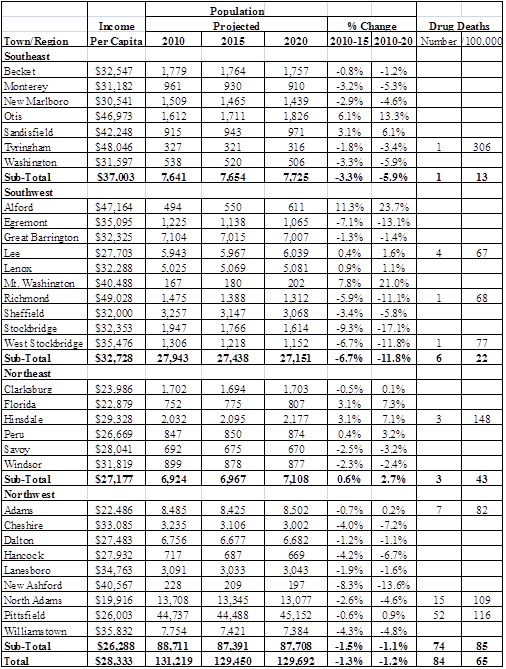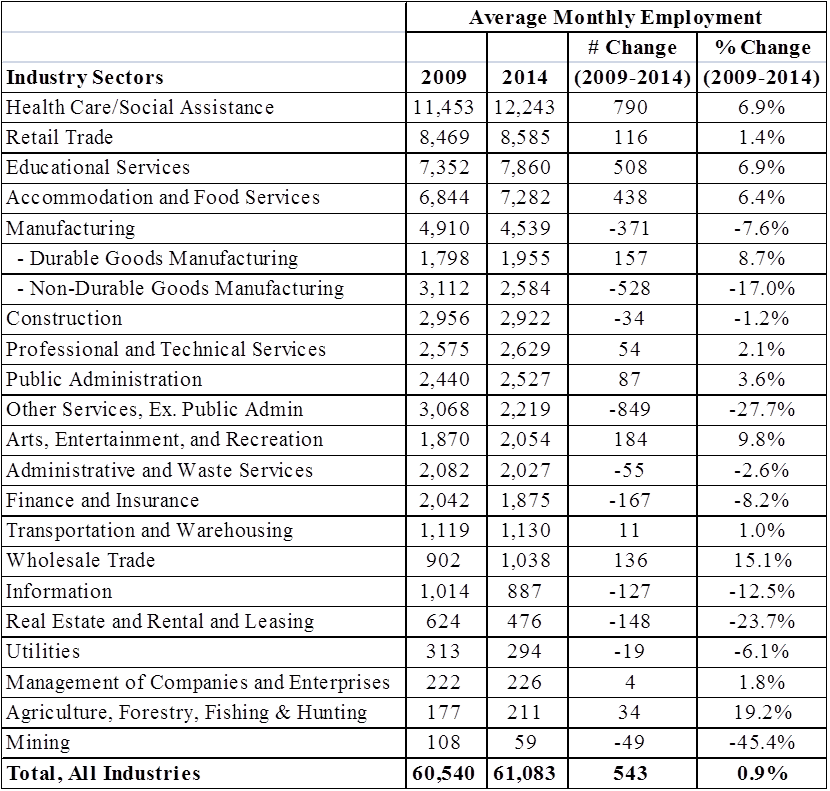Elliott R. Morss ©All Rights Reserved
Introduction
I live in The Berkshires, a small region in the mountains of western Massachusetts. It is bounded by declining industrial towns to the north (Adams North Adams and Pittsfield,) and a former whaling town to the south (Hudson). Efforts to revive these towns have not been successful. But the mid-Berkshires are popular vacation destinations, with outdoor activities including hiking, fall foliage water sports and skiing. In addition, it has world-renowned music, theatrical and arts institutions led by the Boston Symphony Orchestra’s Tanglewood. The purpose here is to look ahead by reviewing the Berkshire economy quantitatively and speculating on the future.
Demographics
Population data for the Berkshire’s cities and towns are provided in Table 1. Its southwest towns have become the real economic drivers of the Berkshires with southeast towns providing complementary bedroom communities. Northern towns have the lowest per capita incomes with Williams College and publicly-supported MASS MoCA serving as small oases of economic activity.
Overall, Berkshire populations are expected to decline over the next decade. But within these four sub-regions, the projected population change differentials are notable: the two regions with the highest per capita incomes (the southern regions) are expected to lose more people far more rapidly than the northern regions. A major dynamic here are the better schools in the south: they “enable” young people to leave (more on this later). Further, as the southern sub-regions are “gentrified” with consequent increases in property values, low income “service” workers move north where living costs are lower.
Table 1. - The Berkshires: Per Capita Incomes and Population Changes

Source: UMass Donahue Institute, US Census
Economic Growth/Decline
Table 2 provides employment data by sector and how it has changed since 2009. But before getting to these numbers, it is important to look further back in history. In 1970, there were more than 20,000 manufacturing workers: manufacturing employment has fallen 78% since then! Even earlier on, there were textile mills and paper factories in the north and river transport via Hudson to the south. Times change.
Back to Table 2. It appears that since 2009, total employment has crept up, largely as a result of a recovery from the bank-collapse induced recession. But growth in the health, education, and “visitor” industries of hotels, motels and restaurants will probably be sustained while manufacturing continues its decline. The real estate, finance and insurance sectors have also lost jobs, probably as a result of growth in Internet information.
Table 2. – Berkshire Employment Growth 2009-2014

Source: US Bureau of Labor Statistics
The Berkshire Economic Dynamic: Educated Young People Leave
Only 29% of Berkshire adults aged 25-44 have a bachelors degree or higher compared to 44% for that age group statewide. Why? What is happening here?
The City Observatory: “The well-educated young people leave: The Young and Restless—25 to 34 year olds with a bachelor’s degree or higher level of education, are increasingly moving to the close-in neighborhoods of the nation’s large metropolitan areas.”
Another source (CEOS for Cities, 2011): “In 2000, young adults with four-year degrees were about 61% more likely to live in close-in urban neighborhoods than their counterparts with less education. Now, those well-educated young adults are about 94% more likely to live in those close-in urban neighborhoods.”
And Sustainable Berkshires: “The region has seen decades of ‘brain-drain” and now has a median age of 44.7 compared to 30.7 in 1970.”
So what is happening? In short, the good Berkshire schools provide students with options and the bright ones leave. On the other end, bad schools generate poorly-educated students and they stay.
Public Education in the Berkshires
The Berkshire region has both “good” and “bad” schools. The good ones are in the top 100 MCAS-ranked schools in Massachusetts:
- Mt. Greylock Regional High (average MCAS score 558, ranking 43 out of 339)
- Lenox Memorial High (MCAS-543, Rank-61)
- Monument Mt Regional High (MCAS-532, Rank-82).
The Berkshires also have “less good” schools:
- Pittsfield - Taconic High (MCAS-485, Rank-218)
- Lee Middle/High School (MCAS-476, Rank-232)
- North Adams - Drury High (MCAS-459, Rank-257)
What Makes Schools Good?
There is no question that the quality of teachers and school facilities are extremely important.
However, it is notable that in North Adams and Pittsfield, the number of children living in single parent homes is high: 61% in North Adams and 54% in Pittsfield. The numbers are much lower in the good school locations: Great Barrington – 35% and only 22% of Lenox children are living in single parent homes. Putting single parent homes together with poverty is a formula for children to have their minds on things other than getting a good education. And certainly these factors go at least some of the way to explaining the differences in MCAS scores.
An editorial aside: Pittsfield is building a new high school: I wonder if this will help.
The Poverty Cycle
As mentioned above, the Berkshires lost 78% of its manufacturing jobs since 1970 with the losses projected to continue through 2018. And even since 2001, BLS data show manufacturing jobs have declined by 44%. So what happens to those who have lost jobs? Some stay and get jobs in another sector. Others leave the region. But some stay, go on unemployment and become part of the underclass. Poverty increases, families break up with alcohol and drugs often involved. Some, along with doctors, get involved in the sale of illegal drugs. The result? There are parts of Adams, North Adams and Pittsfield that are no different than what is found in the “hollowed out” sections of most large US cities.
Table 3 shows data on per capital incomes along with poverty rates, and drug deaths for the region. It is not surprising that poverty rates are high in Adams, North Adams and Pittsfield. But the high rates of poverty in Lenox and Stockbridge are a bit of a surprise. A possible reason for their high rates is that low-wage service people live in these towns.
The Massachusetts Department of Public Health reports that opioid-related deaths in Massachusetts have grown rapidly from 355 in 2000 to 1,659 in 2015. The Berkshire drug death rate per 100,000 is lower than the state average: For the period 2000-15, the Berkshire death rate was 114 versus 166 for the state overall.
Table 3. – Berkshire Poverty and Drug Deaths

Source: US Census
The Economic Development Industry
The Berkshires has a number of development agencies: the Berkshire Regional Planning Commission, 1Berkshire, the Berkshire County Regional Employment Board, various community development agencies and chamber of commerce groups. They are busy, maybe too busy: the Berkshire Regional Planning Commission has come up with a regional plan for the region with more than 50 goals and 100+ policies for its implementation. In all fairness, the Planning Commission wants to establish an “Economic Development District”, compliant with the Economic Development Administration’s requirements. Once the district is established, it will qualify for Federal development grants.
Conclusions
Having reviewed the data, what are the conclusions?
- Manufacturing has left and will not return. This conclusion is buttressed by the all-pervasive political opposition to new natural gas pipes, thereby insuring high energy prices for the foreseeable future.
- The well-educated young people leave for the bright city lights.
- And rest assured, The Berkshires will not become the next Silicon Valley. Spending monies to attract any of these groups will for the most part be wasted.
But there is hope. Wealthy middle age and older people from all over the world like the region. Some just visit while end up moving here. They are attracted by the outdoors, the arts, adequate medical facilities and the “wellness” industry. The Berkshires should “cater” to these groups.
In recognition of declining populations, governments should be consolidated starting with police, fire and public works and ending with schools. I say wait on schools because the good ones don’t want to consolidate now. They believe they can keep course offerings up by attracting increasing numbers of school choice students.
Consolidations can be a tricky business. Senior administrators fearful of losing their jobs can create real roadblocks. However, State Rep. Smitty Pignatelli has come up with a method that should be tried. He wants a single Town Manager appointed for several towns together. Over time, it would become quite clear where consolidations could take place saving money while maintaining service quality.
The drug problem – we should have learned by now: when there is a significant US market for good, it will be supplied. If laws limit its use, it will be supplied by a criminal element. Until we recognize this and change policies, the US will have a drug problem. Cigarettes are well-documented killers. But they are legal. There are age limits on who can buy them, they are taxed heavily and some of the tax revenues being used for treatment and education. This is how illegal drugs should be handled. More on this can be found here.



